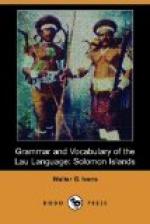Title: Grammar and Vocabulary of the Lau Language
Author: Walter G. Ivens
Release Date: May, 2004 [EBook #5762] [Yes, we are more than one year ahead of schedule] [This file was first posted on August 28, 2002]
Edition: 10
Language: English
Character set encoding: ASCII
*** Start of the project gutenberg EBOOK the lau language ***
Produced by David Starner, with help from Charles Franks and the Distributed Online Proofreading Team.
Transcriber’s Note: Some umlauts and other fine distinctions of Sa’a orthography have been lost. The Lau orthography is correct as given.
GRAMMAR AND VOCABULARY OF THE LAU LANGUAGE: SOLOMON ISLANDS
BY
Walter G. Ivens, M. A., Litt. D.
Carnegie institution of Washington
publication no. 300
Preface.
Lau is the name given to the language spoken by the inhabitants of the artificial islets which lie off the northeast coast of Big Malaita, Solomon Islands. The language spoken on the coast from Uru on the northeast to Langalanga, Alite Harbor, on the northwest of Big Malaita, is practically Lau. On the west coast there is considerable admixture of Fiu, which is the language of the bush behind the Langalanga lagoon. In Dr. Codrington’s “Melanesian Languages,” pp. 39 et seq., certain words are given as spoken at Alite in Langalanga. These words are probably Fiu rather than Lau.
The purest Lau is spoken at Sulufou, one of the artificial islets near Atta Cove. The inhabitants of Ai-lali, on the mainland of Big Malaita opposite the island Aio, are an offshoot of the Lau-speaking peoples. In Port Adam (Malau) on Little Malaita, some 12 miles north of Sa’a, there are two villages, Ramarama and Malede, inhabited by Lau-speaking peoples, and the inhabitants of these villages hold as a tradition that their forefathers migrated from Suraina, near Atta Cove, 80 miles away, along the coast to the north.
The Lau of this grammar and vocabulary was learned from dealings with the Port Adam natives and also from a stay of several weeks with Rev. A. I. Hopkins, at Mangoniia, on the mainland opposite the artificial islet Ferasubua.
It is not claimed that the Lau here presented is the same as the Lau of the northeast coast of Big Malaita. Doubtless owing to the Port Adam peoples being surrounded by Sa’a-speaking peoples, they have adopted Sa’a words and methods of speech to some extent. The women of the hill peoples above Port Adam have largely been procured as wives for the Port Adam men and thus there has been a tendency for the distinctiveness of the Lau language to disappear and for the Sa’a words to be adopted. While this tendency was perhaps




